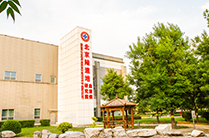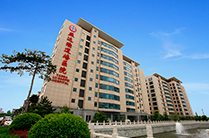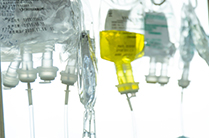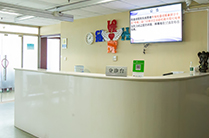What is cancer?
What is leukemia?
Leukemia cells do not usually form tumors, but they can travel with the blood all over the body. That means they can reach almost any organ. So leukemia can be present in many different ways, depending on which organs are involved.
The mortality of leukemia in all age groups of malignant tumors in China accounted for sixth (male) and eighth (female), and in children and under 35 years old group accounted for first. At present, there are more than 2 million children with leukemia in China, increasing at a rate of 30-40 thousand per year.
Symptoms may include:
• Anemia
• Bleeding
• Bruising
• Fever
• Chills
• Loss of appetite
• Loss of weight
• Swollen or tender lymph nodes, liver, or spleen
• Petechiae—tiny red dots under the skin that are the result of very small bleeds.
• Swollen or bleeding gums
• Sweating
• Bone or joint pain
In addition, acute leukemia may cause the following:
• Vomiting
• Confusion
• Loss of muscle control
• Seizures
• Swollen testicles
• Sores in the eyes or on the skin
The symptoms of leukemias may resemble other system disorders or medical problems. Always consult your doctor for a diagnosis as soon as possible.
Two types of abnormal white blood cells can turn into leukemia: lymphoid cells and myeloid cells. When leukemia involves the lymphoid cells, it is called lymphocytic or lymphoblastic leukemia. When it is found in the myeloid cells, it is called myelogenous or myeloid leukemia.
Leukemia is grouped in two ways:
• Acute or chronic, depending on how fast the cells grow
• Lymphocytic or myeloid, depending on the type of white blood cell that has turned into leukemia
In acute leukemia, the abnormal blood cells are usually young cells (immature blasts) that do not work as they should properly. These cells grow quickly. Acute leukemia quickly gets worse unless it is treated right away.
In chronic leukemia, young blood cells are present, but mature, functional cells are also made. In chronic leukemia, blasts grow slowly. It takes longer for the disease to get worse.
These categories result in 4 combinations, which make up the main types of leukemia:
• Acute lymphoblastic leukemia (ALL)
ALL is the most common type of leukemia in children. But about one-third of cases of ALL occur in adults.
• Acute myeloid leukemia (AML)
AML is one of the most common types of acute leukemia in adults. AML can also occur in children. In children, it makes up about 1 in 4 leukemias.
• Chronic lymphocytic leukemia (CLL)
CLL is also among the most common types of leukemia in adults. It is mostly seen in older adults. It is sometimes seen in younger adults, but almost never in children.
• Chronic myelogenous leukemia (CML)
CML is a slightly less common type of leukemia that is seen mostly in adults. Very few children develop this type of leukemia.
In addition to a complete medical history and physical examination, diagnostic procedures for leukemia may include the following:
• Bone marrow aspiration biopsy
Bone marrow aspiration and biopsy can get marrow cells and a small bone ‘chip’ from the marrow for study. A pathologist views the bone marrow, blood, and bone under a microscope to look for signs of cancer. These cells can also be used for flow cytology, fusion gene, gene mutation, chromosome and FISH detection to help make accurate diagnosis.
• Cytogenetic analysis
In this laboratory test, cells in a sample of blood or bone marrow are viewed under a microscope to look for certain changes in the structure or number of chromosomes in the lymphocytes.
• Immunophenotyping
Immunophenotyping is a test in which the cells in a sample of blood or bone marrow are looked at under a microscope to find out if malignant lymphocytes (cancer) began from the B lymphocytes or the T lymphocytes. The process identifies cells based on the types of antigens or markers on the surface of the cell. This process is used to diagnose specific types of leukemia and lymphoma by comparing the cancer cells to normal cells of the immune system.
• Complete blood count (CBC)
• Blood tests
Your evaluation may include the performance of specific blood tests, including (but not limited to) cell counts, measurement of various blood chemistries and markers of inflammation. In some cases, genetic testing may be recommended.
• CT scan
• MRI
• X-ray
• Ultrasound
• Lymph node biopsy
• A lymph node biopsy is the removal of all or part of a lymph node. A pathologist views the tissue under a microscope to look for cancer cells.
• Lumbar puncture (spinal tap)
A lumbar puncture (also called a spinal tap) can be used to analyze the fluid in the spinal cord. This test is helpful for spinal tumor assessment and also for measuring whether certain cancers have spread to the brain.
Treatment for Acute and Chronic Leukemias
Specific treatment for acute and chronic leukemias will be determined by your doctor based on:
• Your age, overall health, and medical history
• Extent of the disease
• Your tolerance for specific medications, procedures, or therapies
• Expectations for the course of the disease
• Your opinion or preference
• Local and systemic treatments
Treatment for cancer is either local or systemic.
Local treatments remove, destroy, or control the cancer cells in one area. Radiation therapy is an example of local treatment.
Doctors use systemic treatments to destroy or control cancer cells throughout your entire body. If you take treatment by mouth or injection, it is considered a systemic treatment. Chemotherapy is an example of systemic treatment. In most cases, treatment for leukemia is systemic because cancer cells are in your bloodstream throughout your body.
You may have just one type of treatment or a combination. Different types of treatment have different goals.
• What Treatment May Include
Blood and bone marrow transplant
A specialized therapy to transfer healthy bone marrow cells into a patient after their own unhealthy bone marrow has been eliminated.
Chemotherapy
The use of anticancer drugs to shrink or kill cancerous cells and reduce cancer spreading to other parts of the body.
Radiation therapy
The use of high-energy radiation to kill or shrink cancer cells, tumors, and non-cancerous diseases.
Immunotherapy
Immunotherapy (also called biological therapy, biological response modifier therapy, or biotherapy) is designed to boost the body's immune system in order to fight cancer. The cells, antibodies, and organs of the immune system work to protect and defend the body against foreign invaders, such as bacteria or viruses. Doctors and researchers have found that the immune system might also be able to both determine the difference between healthy cells and cancer cells in the body, and to eliminate the cancer cells. For example, CAR-T therapy.
Targeted therapies
Targeted therapies can target cancerous cells without affecting healthy tissue, unlike radiation and chemotherapy treatments.
Some newer drugs specifically target abnormal proteins, such as those caused by the Philadelphia chromosome. Drugs such as imatinib (Gleevec) and dasatinib (Sprycel) may be helpful in the treatment of ALL that has this chromosome. These drugs are taken daily as pills.
Biologic therapy
Biologic therapy is treatment with substances that are made naturally in the body or that can block the growth of cancer cells. This approach is designed to minimize the side effects associated with traditional treatments like chemotherapy.
Biologics include nonspecific immunomodulating agents, interferons, interleukins, colony-stimulating factors, monoclonal antibodies and vaccines.
Donor lymphocyte infusion (DLI)
Donor lymphocyte infusion (DLI) is a cancer treatment that may be used after stem cell transplant. Lymphocytes (a type of white blood cell) from the stem cell transplant donor are removed from the donor's blood and may be frozen for storage. The donor's lymphocytes are thawed if they were frozen and then given to the patient through one or more infusions. The lymphocytes see the patient's cancer cells as not belonging to the body and attack them.
Blood transfusion (red blood cells, platelets)
Medications
To prevent or treat damage to other systems of the body caused by leukemia treatment.
• Lu Daopei’s hospital expertise
Patients with leukemia are evaluated and treated in General Hematology and Bone Marrow Transplant department by a team of excellent doctors. We offer advanced treatment protocols for leukemia. Our goal is to improve the survival and quality of life of patients.
(The content above extract from stanfordhealthcare.org)
-
-
Diseases ·
-














 京公网安备13108202000843号
京公网安备13108202000843号